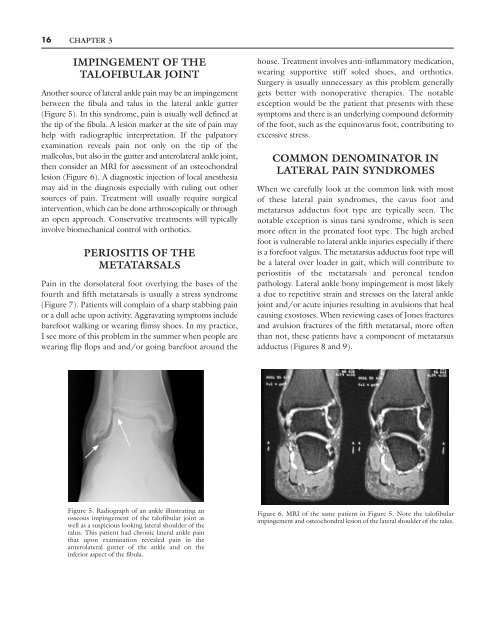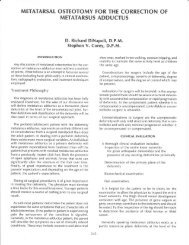lateral pain syndromes of the foot and ankle - The Podiatry Institute
lateral pain syndromes of the foot and ankle - The Podiatry Institute
lateral pain syndromes of the foot and ankle - The Podiatry Institute
You also want an ePaper? Increase the reach of your titles
YUMPU automatically turns print PDFs into web optimized ePapers that Google loves.
16<br />
CHAPTER 3<br />
IMPINGEMENT OF THE<br />
TALOFIBULAR JOINT<br />
Ano<strong>the</strong>r source <strong>of</strong> <strong>lateral</strong> <strong>ankle</strong> <strong>pain</strong> may be an impingement<br />
between <strong>the</strong> fibula <strong>and</strong> talus in <strong>the</strong> <strong>lateral</strong> <strong>ankle</strong> gutter<br />
(Figure 5). In this syndrome, <strong>pain</strong> is usually well defined at<br />
<strong>the</strong> tip <strong>of</strong> <strong>the</strong> fibula. A lesion marker at <strong>the</strong> site <strong>of</strong> <strong>pain</strong> may<br />
help with radiographic interpretation. If <strong>the</strong> palpatory<br />
examination reveals <strong>pain</strong> not only on <strong>the</strong> tip <strong>of</strong> <strong>the</strong><br />
malleolus, but also in <strong>the</strong> gutter <strong>and</strong> antero<strong>lateral</strong> <strong>ankle</strong> joint,<br />
<strong>the</strong>n consider an MRI for assessment <strong>of</strong> an osteochondral<br />
lesion (Figure 6). A diagnostic injection <strong>of</strong> local anes<strong>the</strong>sia<br />
may aid in <strong>the</strong> diagnosis especially with ruling out o<strong>the</strong>r<br />
sources <strong>of</strong> <strong>pain</strong>. Treatment will usually require surgical<br />
intervention, which can be done arthroscopically or through<br />
an open approach. Conservative treatments will typically<br />
involve biomechanical control with orthotics.<br />
PERIOSITIS OF THE<br />
METATARSALS<br />
Pain in <strong>the</strong> dorso<strong>lateral</strong> <strong>foot</strong> overlying <strong>the</strong> bases <strong>of</strong> <strong>the</strong><br />
fourth <strong>and</strong> fifth metatarsals is usually a stress syndrome<br />
(Figure 7). Patients will complain <strong>of</strong> a sharp stabbing <strong>pain</strong><br />
or a dull ache upon activity. Aggravating symptoms include<br />
bare<strong>foot</strong> walking or wearing flimsy shoes. In my practice,<br />
I see more <strong>of</strong> this problem in <strong>the</strong> summer when people are<br />
wearing flip flops <strong>and</strong> <strong>and</strong>/or going bare<strong>foot</strong> around <strong>the</strong><br />
Figure 5. Radiograph <strong>of</strong> an <strong>ankle</strong> illustrating an<br />
osseous impingement <strong>of</strong> <strong>the</strong> tal<strong>of</strong>ibular joint as<br />
well as a suspicious looking <strong>lateral</strong> shoulder <strong>of</strong> <strong>the</strong><br />
talus. This patient had chronic <strong>lateral</strong> <strong>ankle</strong> <strong>pain</strong><br />
that upon examination revealed <strong>pain</strong> in <strong>the</strong><br />
antero<strong>lateral</strong> gutter <strong>of</strong> <strong>the</strong> <strong>ankle</strong> <strong>and</strong> on <strong>the</strong><br />
inferior aspect <strong>of</strong> <strong>the</strong> fibula.<br />
house. Treatment involves anti-inflammatory medication,<br />
wearing supportive stiff soled shoes, <strong>and</strong> orthotics.<br />
Surgery is usually unnecessary as this problem generally<br />
gets better with nonoperative <strong>the</strong>rapies. <strong>The</strong> notable<br />
exception would be <strong>the</strong> patient that presents with <strong>the</strong>se<br />
symptoms <strong>and</strong> <strong>the</strong>re is an underlying compound deformity<br />
<strong>of</strong> <strong>the</strong> <strong>foot</strong>, such as <strong>the</strong> equinovarus <strong>foot</strong>, contributing to<br />
excessive stress.<br />
COMMON DENOMINATOR IN<br />
LATERAL PAIN SYNDROMES<br />
When we carefully look at <strong>the</strong> common link with most<br />
<strong>of</strong> <strong>the</strong>se <strong>lateral</strong> <strong>pain</strong> <strong>syndromes</strong>, <strong>the</strong> cavus <strong>foot</strong> <strong>and</strong><br />
metatarsus adductus <strong>foot</strong> type are typically seen. <strong>The</strong><br />
notable exception is sinus tarsi syndrome, which is seen<br />
more <strong>of</strong>ten in <strong>the</strong> pronated <strong>foot</strong> type. <strong>The</strong> high arched<br />
<strong>foot</strong> is vulnerable to <strong>lateral</strong> <strong>ankle</strong> injuries especially if <strong>the</strong>re<br />
is a fore<strong>foot</strong> valgus. <strong>The</strong> metatarsus adductus <strong>foot</strong> type will<br />
be a <strong>lateral</strong> over loader in gait, which will contribute to<br />
periostitis <strong>of</strong> <strong>the</strong> metatarsals <strong>and</strong> peroneal tendon<br />
pathology. Lateral <strong>ankle</strong> bony impingement is most likely<br />
a due to repetitive strain <strong>and</strong> stresses on <strong>the</strong> <strong>lateral</strong> <strong>ankle</strong><br />
joint <strong>and</strong>/or acute injuries resulting in avulsions that heal<br />
causing exostoses. When reviewing cases <strong>of</strong> Jones fractures<br />
<strong>and</strong> avulsion fractures <strong>of</strong> <strong>the</strong> fifth metatarsal, more <strong>of</strong>ten<br />
than not, <strong>the</strong>se patients have a component <strong>of</strong> metatarsus<br />
adductus (Figures 8 <strong>and</strong> 9).<br />
Figure 6. MRI <strong>of</strong> <strong>the</strong> same patient in Figure 5. Note <strong>the</strong> tal<strong>of</strong>ibular<br />
impingement <strong>and</strong> osteochondral lesion <strong>of</strong> <strong>the</strong> <strong>lateral</strong> shoulder <strong>of</strong> <strong>the</strong> talus.

















